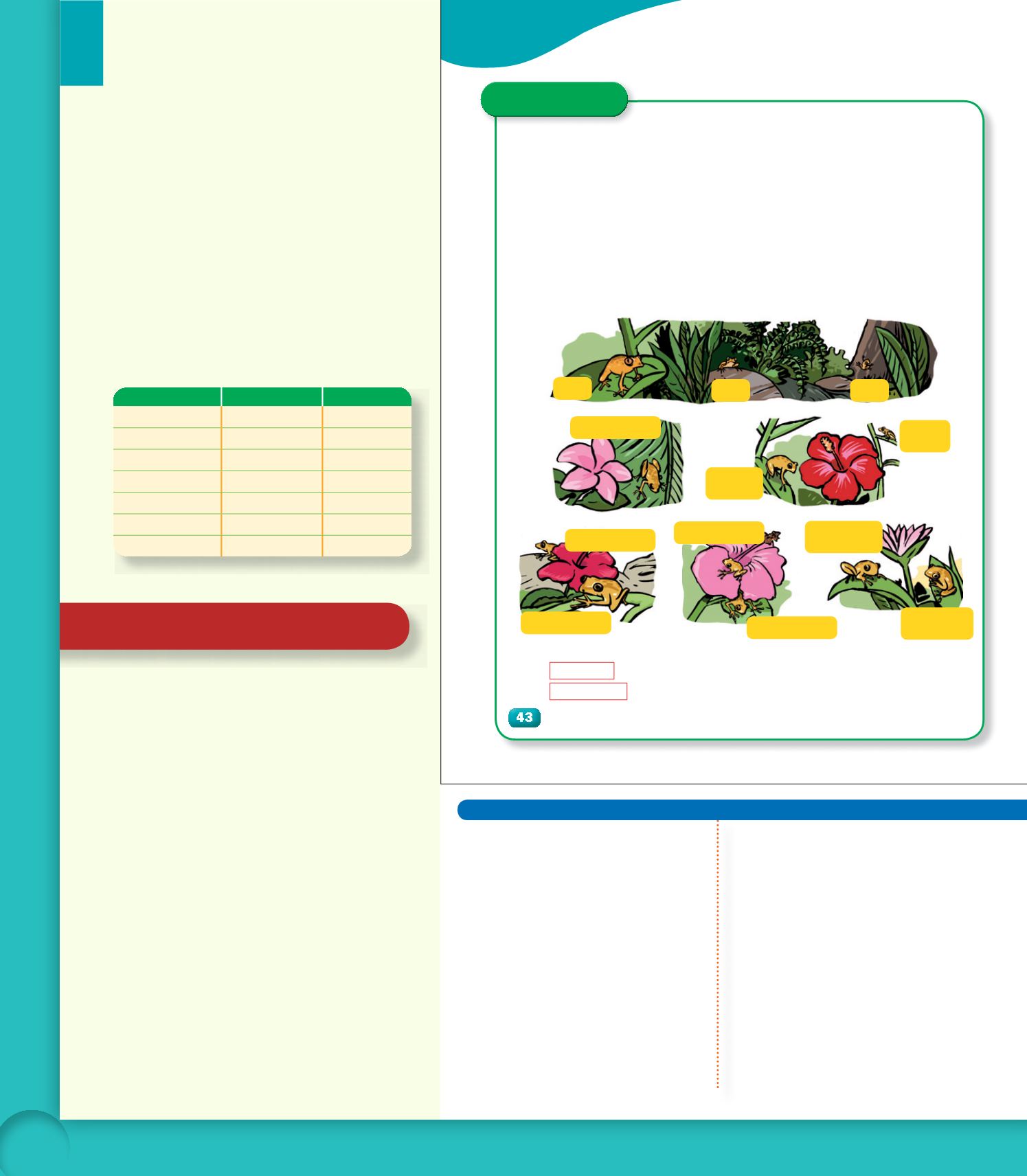

Book 1A Unit 2 Desafío 2
58
200
Presentation
.
In this section, students learn the words and
expressions used to express the location of
people and things using the verb
estar
.
.
Students should be able to ask where something
or someone is, and answer using adverbs of
place or prepositional phrases indicating where
something or someone is in relation to something
or someone else.
.
Students learn about the tropical rainforest
in Puerto Rico.
Gramática – Expresar lugar
DESAFÍO 2
Unit
2
Warm-up/ Independent starter
.
In order to compare the furniture in a hotel with
what one finds in a house, ask students to write
two headings:
En un hotel
and
En una casa
.
.
Students write four sentences in Spanish, two
affirmative and two negative, under each heading
using the words and expressions from the
previous lesson. For example:
En un hotel no hay
un lavaplatos.
Preparation
.
In preparation for this grammar lesson on
locations, ask students to recall what questions
were asked in the
fotonovela
when Tim and Mack
where looking for
coquíes
. Remind them that
Mack asked
¿Dónde están los coquíes?
.
Write the question on the board and have
students look up the answers.
.
Then write the answer on the board:
¡Hay un coquí
en la estantería! ¡Está encima de los libros!
Teaching suggestions
DEVELOPING LEARNERS
r
For more practice listening and writing using
the vocabulary for parts of a house and
furniture, do a dictation activity in class.
r
Ask students to write the numbers 1–5 on a
piece of paper in preparation for a dictation
of five sentences in Spanish.
r
At the end, have students switch papers with
a partner, then write the correct answers on
the board so that students can verify their
partner’s answers. Then ask students to
return the sheets to the original writers.
EXPANDING LEARNERS
r
Draw a picture of a house with its different
rooms. Then ask students to tell you what
rooms are next to each other:
La cocina está
al lado del comedor
.
r
Then expand the activity with two new
phrases to express where something is
located:
está a la izquierda de (del, de la),
está a la derecha de (del, de la)
. You may
also add the words
arriba
and
abajo
.
11
Differentiated instruction
Activities
Standards
Resources
Gramática
3.1, 4.1
43.
4.1
44.
1.1
45.
1.3
46.
1.3, 5.1
47. Conexiones 1.1, 1.2, 3.1
Tu desafío
3.1, 3.2
DJFOUP EJF[
DESAFÍO 2
&YQSFTBS MVHBS
(SBNÈUJDB
3FNFNCFS UIFTF DPOUSBDUJPOT
B FM
BM
&M DPRVÓ FTUÈ
BM MBEP EF
MB GMPS
EF FM
EFM
&M DPRVÓ FTUÈ
FODJNB EFM
MJCSP
$PNQBSBDJØO
8IBU DPOUSBDUJPOT BSF UIFSF JO &OHMJTI "SF UIFZ PQUJPOBM PS OPU
-B DPOTUSVDDJØO
FTUBS FO
r
5P TBZ XIFSF UIJOHT BSF VTF UIF WFSC
FTUBS
GPMMPXFE CZ XPSET UIBU FYQSFTT QMBDF
&M DPRVÓ
FTUÈ FO FM KBSEÓO
r
5IF QSFQPTJUJPO
FO
FYQSFTTFT MPDBUJPO *U JT FRVJWBMFOU UP UIF &OHMJTI XPSET
BU JO PO
BOE
JOTJEF
&M DPRVÓ FTUÈ
FO
MB TBMB &M DPRVÓ FTUÈ
FO
MB FTUBOUFSÓB
"EWFSCJPT Z FYQSFTJPOFT EF MVHBS
r
.BOZ PUIFS XPSET BOE QISBTFT BSF VTFE UP TIPX MPDBUJPO
y%ØOEF FTUÈO MPT DPRVÓFT
BRVÆ
BM MBEP EF
MB GMPS
DFSDB EF
MB GMPS
MFKPT EF
MB GMPS
BIÆ
FODJNB EF
MB GMPS
EFCBKP EF
MB GMPS
BMMÆ
B MB J[RVJFSEB
EF
MB GMPS
B MB EFSFDIB
EF
MB GMPS
EFUS»T EF
MB GMPS
EFMBOUF EF
MB GMPS


















